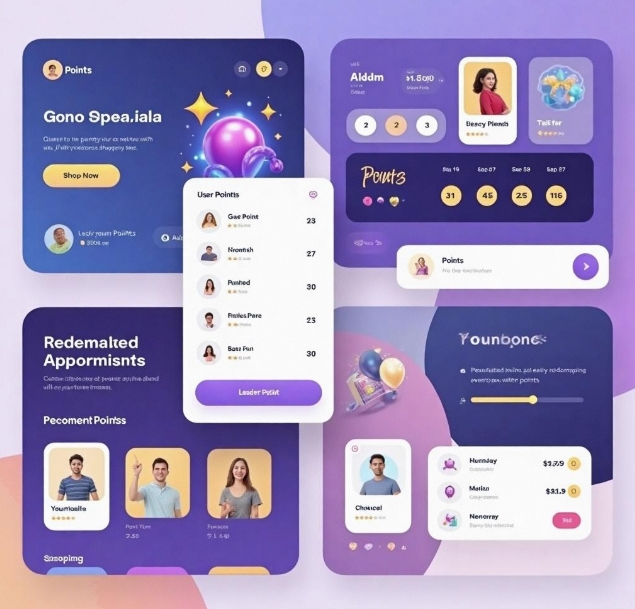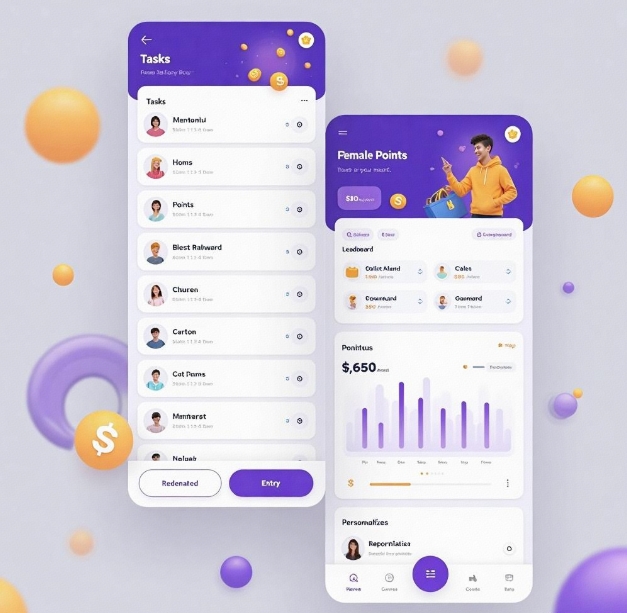How to introduce gamification mechanisms in the points mall to enhance interaction?
- latest articles
- 1.DApp Development & Customization: Merging Diverse Market Needs with User Experience 2.Analysis of the Core Technical System in DApp Project Development 3.How to achieve cross-chain interoperability in Web3 projects? 4.How does the tokenization of points reconstruct the e-commerce ecosystem? 5.How to Set and Track Data Metrics for a Points Mall? 6.What is DApp Development? Core Concepts and Technical Analysis 7.Inventory of commonly used Web3 development tools and usage tips 8.Development of a Distribution System Integrated with Social E-commerce 9.Six Key Steps for Businesses to Build a Points Mall System 10.What is DApp Development? A Comprehensive Guide from Concept to Implementation
- Popular Articles
- 1.Future Trends and Technology Predictions for APP Development in 2025 2.Analysis of the DeFi Ecosystem: How Developers Can Participate in Decentralized Finance Innovation 3.From Zero to One: How PI Mall Revolutionizes the Traditional E-commerce Model 4.DAPP Development | Best Practices for Professional Customization and Rapid Launch 5.Recommended by the Web3 developer community: the most noteworthy forums and resources 6.How to Develop a Successful Douyin Mini Program: Technical Architecture and Best Practices 7.From Cloud Computing to Computing Power Leasing: Building a Flexible and Scalable Computing Resource Platform 8.Shared Bike System APP: The Convenient Choice in the Era of Smart Travel 9.How to Create a Successful Dating App: From Needs Analysis to User Experience Design 10.From Design to Development: The Complete Process of Bringing an APP Idea to Life
With the development of the internet and the continuous changes in user demands, points-based marketplaces have become one of the important tools for businesses to interact with users. By allowing users to participate in activities such as consumption, check-ins, and reviews to accumulate points and redeem them for goods or services, points-based marketplaces have become an effective means to enhance customer engagement and improve user loyalty. However, a simple points redemption system often leads to low user participation, insufficient marketplace activity, and even situations where "points are useless." Therefore, how to enhance user interaction in points-based marketplaces through innovative methods has become an important issue for businesses to consider.
In recent years, gamification mechanisms, as a new approach to user engagement design, have gradually entered various fields. Their application in points-based marketplaces, in particular, has become a significant means to enhance user experience and interaction. This article will explore how to introduce gamification mechanisms into points-based marketplaces and, through the design of appropriate gamification elements, enhance users' sense of participation, achievement, and interactivity.
I. Basic Concepts of Gamification Mechanisms
Gamification is a method that applies game design elements and game mechanisms to non-game environments. By introducing elements such as game rules, challenges, rewards, and levels into a system, it stimulates users' desire to participate and their sense of achievement. The core of gamification is to enhance users' sense of participation and achievement, allowing them to experience fun and satisfaction similar to that in games, even in non-game scenarios.
Common elements of gamification include:
Points System: Allows users to accumulate points through tasks, activities, and other means.
Levels and Rankings: Motivates users to continuously improve their level and ranking by setting user levels and ranking mechanisms.
Tasks and Challenges: Sets a series of tasks or challenges that users can complete to earn rewards.
Reward Mechanisms: Provides virtual rewards, physical rewards, coupons, etc., to incentivize users to continue participating.
Achievements and Badges: Records users' gaming processes and achievements through an achievement system, stimulating their sense of honor.
Through the design of these elements, gamification can effectively motivate user participation and interaction, increasing user engagement.
II. The Necessity of Introducing Gamification Mechanisms in Points-Based Marketplaces
The main purpose of introducing gamification mechanisms in points-based marketplaces is to enhance user activity, increase user engagement, and strengthen users' sense of participation through fun and challenge. Specifically, the following aspects demonstrate the necessity of gamification mechanisms in points-based marketplaces:
Enhancing User Engagement: Traditional points-based marketplaces may suffer from low user engagement, especially when marketplace activities are monotonous and product redemption options are limited. Introducing gamification mechanisms through tasks, challenges, leaderboards, and other methods can effectively stimulate users' desire to participate, encouraging them to more actively engage in various marketplace activities.
Increasing User Stickiness: The redemption mechanisms in points-based marketplaces are often relatively simple. The introduction of gamification elements can add more fun and challenge to the marketplace, allowing users to experience a sense of achievement similar to that in games while earning rewards. As users complete levels and tasks, their loyalty and dependence on the platform will gradually increase.
Providing Personalized Experiences: Gamification mechanisms can provide personalized tasks, rewards, and other content based on user behavior, meeting the needs of different users. For example, for users who enjoy challenging tasks, higher difficulty tasks can be set; for users who focus more on rewards, opportunities to redeem more physical rewards can be provided. Personalized settings allow users to find activities and goals that interest them.
Enhancing Social Interaction: Introducing social elements, such as friend leaderboards and team tasks, can enhance interaction among users. Users can not only interact with the platform within the marketplace but also interact with other users, completing tasks together or competing for rankings, thereby increasing sociability and interactivity.
III. How to Introduce Gamification Mechanisms in Points-Based Marketplaces
To effectively introduce gamification mechanisms in points-based marketplaces, design must be approached from multiple angles to ensure the desired enhancement of interaction is achieved. Below are several common gamification design strategies:
1. Setting Tasks and Challenges
Tasks and challenges are among the most basic elements of gamification. In points-based marketplaces, businesses can set various tasks to incentivize users to complete specific behaviors. For example:
Daily Tasks: Users can earn corresponding point rewards by logging into the marketplace daily, browsing products, making purchases, etc.
Weekly/Monthly Challenges: Set weekly/monthly tasks based on user activity or consumption, such as accumulating a certain amount of spending or inviting friends to register, with generous rewards upon completion.
Through these tasks and challenges, users can not only continuously accumulate points but also gain a sense of achievement by completing tasks, thereby increasing their engagement with the marketplace.
2. Introducing Level and Experience Systems
Level systems are common elements in many games and are an important part of gamification mechanisms. In points-based marketplaces, businesses can set user levels and assign different levels based on factors such as user activity, spending amount, and the number of tasks completed. For example:
Levels such as Novice, Regular, Expert: Users automatically advance their levels based on participation. Users at different levels can enjoy different privileges, such as higher point redemption rates, a wider selection of products, etc.
Experience Point System: Users earn a certain amount of experience points each time they complete a task or make a purchase. Once experience points accumulate to a certain level, users can advance to a higher level and receive better rewards.
Through level and experience systems, businesses can motivate users to continuously strive to improve their levels, thereby increasing their dependence on and loyalty to the marketplace.
3. Designing Leaderboards and Competitive Modes
Leaderboards are an indispensable part of gamification elements, as they can stimulate users' competitive spirit. In points-based marketplaces, businesses can establish different leaderboards based on user data such as points, task completion rates, and shopping amounts. For example:
Monthly Points Leaderboard: Users are ranked based on the number of points earned in the current month, with the top few receiving physical prizes or large point rewards.
Spending Leaderboard: Encourages users to spend more in the marketplace through rankings based on spending amounts.
Team Competitions: Users can form teams with other users to complete tasks together, with team members sharing rewards upon task completion.
The introduction of leaderboards not only enhances users' competitive awareness but also increases their sense of participation and fun through social interaction.
4. Reward and Incentive Mechanisms
Reward mechanisms are the most direct form of incentive in gamification design. In points-based marketplaces, businesses can set up various forms of rewards, including:
Point Rewards: Users are rewarded with a certain number of points after completing tasks, purchasing products, or reaching a certain level. Points can be used for marketplace redemptions.
Virtual Rewards: Such as badges, titles, etc., giving users a sense of achievement and honor.
Physical Rewards: Businesses can provide actual product rewards or shopping vouchers based on points or task completion.
By reasonably setting up reward mechanisms, users can be incentivized to participate more actively in marketplace activities, increasing their frequency of participation.
5. Social Interaction and Cooperation
Social elements can significantly enhance the effectiveness of gamification. In points-based marketplaces, businesses can enhance social interaction through the following methods:
Friend Invitations: Encourages users to invite friends to register and make purchases, with rewards based on the number of invitations.
Team Cooperation: Sets team tasks where users can form teams with friends or other users to complete tasks together and share rewards.
Social Sharing: Users can share their task completions or rewards on social media, increasing the marketplace's exposure.
Social interaction can stimulate users' social needs and increase interaction among users through team cooperation and ranking competitions.
IV. Summary
By introducing gamification mechanisms, points-based marketplaces can not only enhance user interaction and a sense of participation but also strengthen user loyalty and engagement with the platform. When designing gamification mechanisms, businesses need to reasonably set elements such as tasks, rewards, levels, and leaderboards based on their own business needs and user characteristics to effectively improve user experience and interaction. The application of gamification mechanisms can not only increase user activity but also bring higher conversion rates and user stickiness to the platform, thereby achieving the goal of enhancing brand loyalty and market competitiveness.
Through continuous innovation and optimization of gamification mechanisms, points-based marketplaces will no longer be mere consumption platforms but will become user communities full of fun, interaction, and challenges, promoting long-term positive interaction between the brand and its users.
-

How does the tokenization of points reconstruct the e-commerce ecosystem?
With the continuous advancement of internet technology and the gradual prolifera···
-

How to Set and Track Data Metrics for a Points Mall?
With the rapid development of the e-commerce industry, points malls, as a common···
-

Development of a Distribution System Integrated with Social E-commerce
With the rapid development of internet technology, the e-commerce industry has e···

 Blockchain
Blockchain












